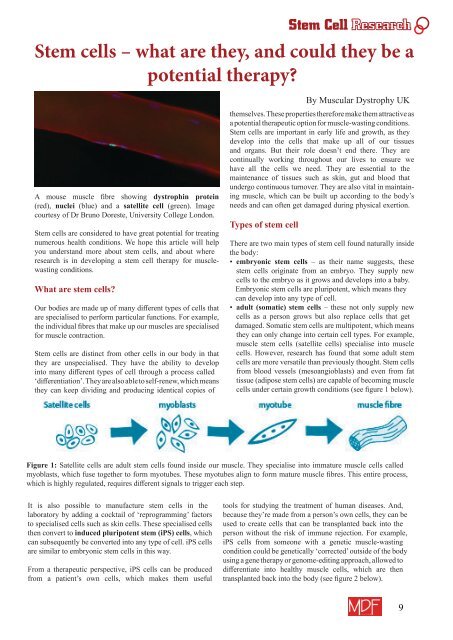MDF Magazine Newsletter Issue 55 April 2018
Create successful ePaper yourself
Turn your PDF publications into a flip-book with our unique Google optimized e-Paper software.
Stem Cell<br />
Stem cells – what are they, and could they be a<br />
potential therapy?<br />
A mouse muscle fibre showing dystrophin protein<br />
(red), nuclei (blue) and a satellite cell (green). Image<br />
courtesy of Dr Bruno Doreste, University College London.<br />
Stem cells are considered to have great potential for treating<br />
numerous health conditions. We hope this article will help<br />
you understand more about stem cells, and about where<br />
research is in developing a stem cell therapy for musclewasting<br />
conditions.<br />
What are stem cells?<br />
Our bodies are made up of many different types of cells that<br />
are specialised to perform particular functions. For example,<br />
the individual fibres that make up our muscles are specialised<br />
for muscle contraction.<br />
Stem cells are distinct from other cells in our body in that<br />
they are unspecialised. They have the ability to develop<br />
into many different types of cell through a process called<br />
‘differentiation’. They are also able to self-renew, which means<br />
they can keep dividing and producing identical copies of<br />
themselves. These properties therefore make them attractive as<br />
a potential therapeutic option for muscle-wasting conditions.<br />
Stem cells are important in early life and growth, as they<br />
develop into the cells that make up all of our tissues<br />
and organs. But their role doesn’t end there. They are<br />
continually working throughout our lives to ensure we<br />
have all the cells we need. They are essential to the<br />
maintenance of tissues such as skin, gut and blood that<br />
undergo continuous turnover. They are also vital in maintaining<br />
muscle, which can be built up according to the body’s<br />
needs and can often get damaged during physical exertion.<br />
Types of stem cell<br />
By Muscular Dystrophy UK<br />
There are two main types of stem cell found naturally inside<br />
the body:<br />
• embryonic stem cells – as their name suggests, these<br />
stem cells originate from an embryo. They supply new<br />
cells to the embryo as it grows and develops into a baby.<br />
Embryonic stem cells are pluripotent, which means they<br />
can develop into any type of cell.<br />
• adult (somatic) stem cells – these not only supply new<br />
cells as a person grows but also replace cells that get<br />
damaged. Somatic stem cells are multipotent, which means<br />
they can only change into certain cell types. For example,<br />
muscle stem cells (satellite cells) specialise into muscle<br />
cells. However, research has found that some adult stem<br />
cells are more versatile than previously thought. Stem cells<br />
from blood vessels (mesoangioblasts) and even from fat<br />
tissue (adipose stem cells) are capable of becoming muscle<br />
cells under certain growth conditions (see figure 1 below).<br />
Figure 1: Satellite cells are adult stem cells found inside our muscle. They specialise into immature muscle cells called<br />
myoblasts, which fuse together to form myotubes. These myotubes align to form mature muscle fibres. This entire process,<br />
which is highly regulated, requires different signals to trigger each step.<br />
It is also possible to manufacture stem cells in the<br />
laboratory by adding a cocktail of ‘reprogramming’ factors<br />
to specialised cells such as skin cells. These specialised cells<br />
then convert to induced pluripotent stem (iPS) cells, which<br />
can subsequently be converted into any type of cell. iPS cells<br />
are similar to embryonic stem cells in this way.<br />
From a therapeutic perspective, iPS cells can be produced<br />
from a patient’s own cells, which makes them useful<br />
tools for studying the treatment of human diseases. And,<br />
because they’re made from a person’s own cells, they can be<br />
used to create cells that can be transplanted back into the<br />
person without the risk of immune rejection. For example,<br />
iPS cells from someone with a genetic muscle-wasting<br />
condition could be genetically ‘corrected’ outside of the body<br />
using a gene therapy or genome-editing approach, allowed to<br />
differentiate into healthy muscle cells, which are then<br />
transplanted back into the body (see figure 2 below).<br />
9


















